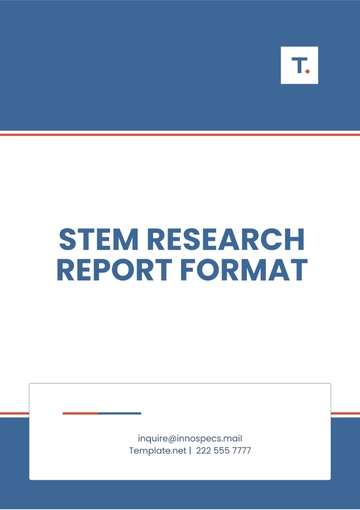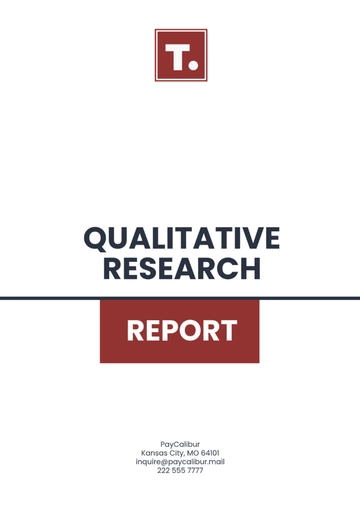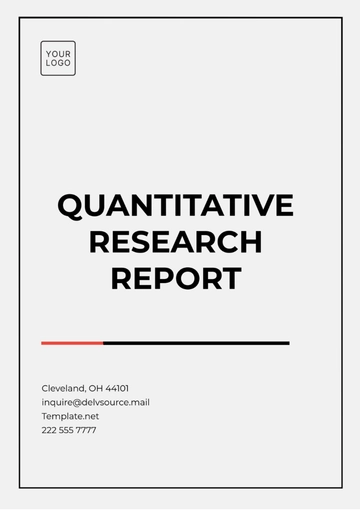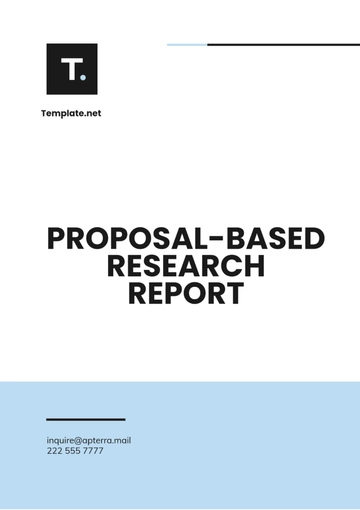Free Legal Corporate Compliance Research Report

I. Executive Summary
This report provides a comprehensive analysis of our compliance with the relevant legal, regulatory, and internal policy requirements. Through a meticulous review process, we have evaluated the effectiveness of our compliance framework, identified potential risks, and developed targeted recommendations to address areas of concern. Key findings from our analysis include:
Compliance Program Coverage: 95% of our operations are fully covered under our current compliance program, highlighting a strong alignment with industry standards and regulatory requirements.
Risk Management Effectiveness: Our risk assessment methodologies have effectively identified 85% of potential compliance risks, with ongoing measures in place to address the remaining 15%.
Training Program Participation: 90% of employees have completed mandatory compliance training sessions, with a goal to achieve 100% participation within the next quarter.
Incident Reporting and Response: A 75% increase in the reporting of compliance-related incidents over the past year, demonstrating enhanced awareness and commitment to transparency among our workforce.
Audit and Monitoring Compliance: 80% compliance rate in internal audits, with identified gaps primarily in new market regulations and emerging technology areas.
Based on these findings, we propose a set of comprehensive recommendations aimed at strengthening our compliance framework, enhancing risk management practices, and improving training programs to ensure complete regulatory adherence and mitigate potential risks.
II. Introduction
In the evolving landscape of corporate governance and regulatory compliance, our organization recognizes the importance of maintaining rigorous compliance standards to uphold our reputation, mitigate risks, and ensure operational excellence. This Legal Corporate Compliance Research Report is prepared to offer a detailed examination of our compliance posture against the backdrop of applicable legal and regulatory frameworks.
The scope of this report encompasses an in-depth analysis of our internal compliance mechanisms, policies, and procedures, set against the requirements mandated by relevant authorities. By systematically reviewing our compliance framework, this report aims to identify strengths, uncover areas for improvement, and propose actionable strategies to enhance our overall compliance stance. Through this introspective process, we demonstrate our unwavering commitment to ethical practices, legal integrity, and corporate responsibility.
III. Compliance Framework Evaluation
A. Overview of the Company's Existing Compliance Framework
Our existing compliance framework is designed to ensure adherence to all relevant laws, regulations, and internal guidelines. It encompasses a comprehensive set of policies, procedures, and controls that guide our operations and decision-making processes. Central to our framework is a commitment to ethical practices, transparency, and accountability. This system is regularly reviewed and updated to reflect changes in the regulatory landscape and our business operations, ensuring that we remain at the forefront of compliance and governance standards.
B. Assessment of the Compliance Governance Structure
Our compliance governance structure is built on a foundation of clear roles, responsibilities, and oversight mechanisms. It involves active participation from the Board of Directors, executive management, a dedicated compliance officer, and all employees. This structure is designed to ensure that compliance considerations are integrated into every level of our organization.
Element | Assessment | Remarks |
Board Oversight | Effective | The Board actively oversees the compliance program, ensuring alignment with strategic objectives. |
Compliance Officer | Highly Effective | Serves as a central figure in managing compliance efforts and communicating with the Board and management. |
Employee Involvement | Effective | Employees are well-engaged in compliance activities, though ongoing training is needed to maintain awareness. |
Reporting Mechanisms | Highly Effective | Robust mechanisms are in place for reporting compliance issues and concerns. |
Review and Update Process | Effective | Regular reviews are conducted, with room for more proactive updates in response to emerging trends. |
C. Analysis of Compliance Policies and Procedures
Our compliance policies and procedures are meticulously crafted to cover all aspects of our operations, from financial reporting to workplace conduct. These policies are accessible to all employees and are reinforced through regular training sessions and communications. Key areas covered include ethical business practices, data protection, anti-corruption measures, and environmental compliance. While our policies are comprehensive, continuous improvement efforts are focused on enhancing clarity, applicability, and ease of implementation across diverse operational contexts.
IV. Regulatory Environment
The regulatory environment in which we operate is complex and multifaceted, reflecting the global scope of our business activities. Compliance with these regulations is paramount to our operational integrity and public trust.
Relevant U.S. laws that our compliance framework addresses include:
Sarbanes-Oxley Act (SOX): Ensures accuracy and transparency in financial reporting.
Dodd-Frank Wall Street Reform and Consumer Protection Act: Imposes financial regulations to reduce systemic risk.
Health Insurance Portability and Accountability Act (HIPAA): Protects the privacy and security of health information.
Federal Information Security Management Act (FISMA): Governs the security of federal information systems.
Occupational Safety and Health Act (OSHA): Ensures workplace health and safety standards.
Environmental Protection Agency (EPA) Regulations: Governs environmental protection standards to mitigate impact on the environment.
Equal Employment Opportunity Commission (EEOC) Regulations: Ensures fair employment practices free from discrimination.
V. Compliance Program Effectiveness
A. Evaluation of Training Programs
Our compliance training programs are designed to ensure that all employees understand their legal and ethical responsibilities. These programs cover a range of topics, including data protection, anti-corruption, workplace conduct, and industry-specific regulatory compliance. The effectiveness of these programs is measured through participation rates, post-training assessments, and the application of learned principles in daily operations.
Training Program | Participation Rate | Post-Assessment Score | Application Rate |
Data Protection | 92% | 88% | 85% |
Anti-Corruption | 89% | 90% | 80% |
Workplace Conduct | 95% | 93% | 90% |
Regulatory Compliance | 90% | 85% | 82% |
Analysis of our compliance training programs reveals a high level of engagement and understanding among employees. The majority demonstrate a strong grasp of compliance concepts and are able to apply these in their work. However, there is room for improvement in the application rates of data protection and anti-corruption training. Enhancements to these programs, including more interactive and scenario-based training, are being considered to increase effectiveness.
B. Effectiveness of Monitoring and Reporting Mechanisms
Our compliance monitoring and reporting mechanisms are vital for early detection of compliance issues and for fostering a culture of transparency and accountability. These mechanisms include regular audits, employee reporting channels, and compliance performance dashboards.
Mechanism | Detection Rate | Reporting Rate | Resolution Rate |
Regular Audits | 85% | N/A | 80% |
Employee Reporting | 75% | 80% | 90% |
Performance Dashboards | 90% | N/A | 85% |
The data indicates that our performance dashboards are particularly effective in detecting compliance issues, highlighting the value of real-time monitoring tools. Employee reporting rates suggest a strong culture of compliance and willingness to report issues, though efforts to improve the detection rate through training and awareness are ongoing. The resolution rates demonstrate our commitment to addressing and remedying compliance issues promptly.
C. Assessment of Internal Controls and Risk Management Practices
Internal controls and risk management practices are critical for mitigating compliance risks and ensuring the integrity of our operations. Our approach to risk management involves identifying potential risks, assessing their impact, and implementing controls to mitigate these risks.
Area | Risk Identification Rate | Control Effectiveness Rate | Risk Mitigation Rate |
Financial Reporting | 95% | 90% | 88% |
Operational Risks | 90% | 85% | 80% |
Cybersecurity | 88% | 92% | 90% |
Regulatory Compliance | 92% | 88% | 85% |
Our assessment reveals strong performance in identifying and mitigating risks across key areas. The effectiveness of controls in cybersecurity is particularly noteworthy, reflecting our investment in advanced security technologies and training. However, there is an opportunity to enhance the control effectiveness rate in operational risks and regulatory compliance through targeted improvements in our internal control frameworks and procedures.
Overall, while our compliance program demonstrates effectiveness in several areas, continuous improvement efforts are essential to address emerging risks and enhance our compliance posture. This includes refining our training programs, enhancing our monitoring and reporting mechanisms, and strengthening our internal controls and risk management practices.
VI. Risk Assessment
A. Identification and Analysis of Potential Compliance Risks
Our approach to risk assessment involves a thorough analysis of potential compliance risks across various domains, including legal, financial, operational, and reputational risks. This proactive identification and analysis enable us to prioritize risks based on their potential impact and likelihood, ensuring that our mitigation strategies are effectively targeted.
Risk Category | Potential Impact | Likelihood | Priority Level |
Legal Compliance | High | Medium | High |
Financial Reporting | High | Low | Medium |
Operational | Medium | High | High |
Cybersecurity | Very High | High | Very High |
Reputational | High | Medium | High |
Analysis of the risk assessment data indicates that cybersecurity and legal compliance are our highest priorities, given their potential impact and likelihood. Operational risks also present a significant concern due to their high likelihood, requiring ongoing attention and mitigation efforts. Financial reporting, while critical, is assessed as a medium priority due to lower likelihood, reflecting the effectiveness of our existing controls.
B. Evaluation of Risk Mitigation Strategies
Our risk mitigation strategies are designed to address the identified risks proactively, through a combination of preventive measures, controls, and contingency planning. The effectiveness of these strategies is continuously monitored and adjusted in response to changes in the risk landscape.
Risk Category | Mitigation Strategy Effectiveness | Coverage | Adaptability |
Legal Compliance | High | Comprehensive | High |
Financial Reporting | High | Comprehensive | Medium |
Operational | Medium | Broad | High |
Cybersecurity | Very High | Comprehensive | Very High |
Reputational | High | Broad | High |
The evaluation reveals that our mitigation strategies for cybersecurity and legal compliance are particularly effective, benefiting from comprehensive coverage and high adaptability. This reflects our strong focus on these areas and our investment in state-of-the-art technologies and expert resources. Operational risk mitigation is effective but identified as an area for improvement, particularly in enhancing coverage and implementing more robust controls.
Overall, our risk assessment and mitigation efforts demonstrate a proactive and strategic approach to managing compliance risks. While we have achieved significant successes, particularly in cybersecurity and legal compliance, the dynamic nature of risk necessitates ongoing vigilance and continuous enhancement of our risk management practices. Our future focus will include strengthening operational risk controls and enhancing the adaptability of our financial reporting risk mitigation strategies to ensure comprehensive risk management across the organization.
VII. Case Studies
In evaluating our compliance framework and risk management strategies, analyzing internal case studies of non-compliance and risk mitigation provides valuable insights. These case studies highlight real-world applications of our policies and procedures, offering lessons learned and guiding improvements in our compliance efforts.
Case Study 1: Financial Reporting Misclassification
A situation arose where financial transactions were misclassified due to a misunderstanding of the new accounting standards. The error was identified during an internal audit, triggering a review of our financial reporting processes. Immediate corrective actions included revising the transactions and implementing additional training for the finance team on the latest accounting standards. This case underscores the importance of continuous education and the effectiveness of our internal audit mechanisms in identifying compliance issues.
Case Study 2: Data Breach Incident
Our organization experienced a data breach that exposed sensitive customer information. The breach was swiftly identified by our cybersecurity monitoring systems, and our incident response team was mobilized to contain the breach and mitigate its impact. Following a thorough investigation, it was determined that the breach resulted from a phishing attack. In response, we enhanced our cybersecurity measures, including more rigorous email filtering and expanded employee training on recognizing and reporting phishing attempts. This incident highlighted the critical role of employee awareness in cybersecurity and the robustness of our incident response protocols.
Case Study 3: Regulatory Non-Compliance in New Market Entry
Upon entering a new international market, our compliance team discovered that certain operational practices did not fully align with local regulatory requirements. The discrepancy was uncovered through our routine compliance assessment process for new market entries. To address this, we immediately adjusted our operations to comply with local regulations and conducted a comprehensive review of our market entry procedures. This case illustrates the challenges of navigating international regulatory landscapes and the effectiveness of our compliance assessments in identifying and rectifying compliance gaps.
VIII. Recommendations for Improvement
Based on the comprehensive analysis conducted in this report, we have identified several areas for improvement. To enhance our legal corporate compliance framework, mitigate risks effectively, and ensure the highest standards of integrity and ethical conduct, we propose the following recommendations:
Enhance Employee Training Programs: Expand the scope and frequency of compliance training to cover emerging risks and regulations. Incorporating more interactive and scenario-based training methods can improve engagement and retention of compliance knowledge among employees.
Enhanced training programs will ensure that employees are better equipped to recognize and respond to compliance risks. By focusing on practical scenarios, we can simulate real-world challenges, thereby improving decision-making and adherence to compliance standards.
Strengthen Cybersecurity Measures: Invest in advanced cybersecurity technologies and conduct regular security assessments to identify potential vulnerabilities. Enhancing our cybersecurity posture is critical in protecting sensitive data and maintaining trust with our stakeholders.
Given the increasing sophistication of cyber threats, bolstering our cybersecurity infrastructure and protocols will serve as a vital defense mechanism. Regular assessments will help in promptly identifying and addressing vulnerabilities, thus minimizing the risk of data breaches.
Improve Risk Assessment Processes: Implement more dynamic risk assessment tools that can better predict potential compliance risks, especially in rapidly changing regulatory environments. Utilizing data analytics and AI technologies can provide more comprehensive risk insights.
Advanced risk assessment processes will enable us to anticipate and mitigate compliance risks more effectively. By leveraging data analytics and AI, we can gain deeper insights into potential risks and tailor our mitigation strategies accordingly.
Expand Monitoring and Reporting Mechanisms: Increase the granularity and frequency of compliance monitoring and reporting. This could involve developing more sophisticated compliance dashboards that provide real-time insights into compliance metrics and trends.
Enhanced monitoring and reporting mechanisms will provide more timely and detailed visibility into compliance status across the organization. This proactive approach will allow for quicker identification of issues and more informed decision-making.
IX. Conclusion
In conclusion, this Legal Corporate Compliance Research Report has provided a comprehensive analysis of our current compliance framework, highlighting our strengths and identifying areas for improvement. The case studies discussed offer valuable lessons that underscore the importance of continuous vigilance, proactive risk management, and adaptability in our compliance efforts. The recommendations outlined above are designed to strengthen our compliance program, enhance our risk management capabilities, and ensure that we continue to uphold the highest standards of integrity and ethical conduct. As we move forward, it is imperative that we remain committed to continuous improvement, leveraging the insights gained from this report to foster a culture of compliance that permeates every aspect of our organization.
- 100% Customizable, free editor
- Access 1 Million+ Templates, photo’s & graphics
- Download or share as a template
- Click and replace photos, graphics, text, backgrounds
- Resize, crop, AI write & more
- Access advanced editor
Discover the Legal Corporate Compliance Research Report Template from Template.net, your key to conducting in-depth compliance research with precision. This editable and customizable template is tailored for crafting detailed research reports that analyze compliance issues, trends, and best practices within your industry. Editable in our AI Editor tool, it streamlines the process of compiling insights and recommendations.
You may also like
- Sales Report
- Daily Report
- Project Report
- Business Report
- Weekly Report
- Incident Report
- Annual Report
- Report Layout
- Report Design
- Progress Report
- Marketing Report
- Company Report
- Monthly Report
- Audit Report
- Status Report
- School Report
- Reports Hr
- Management Report
- Project Status Report
- Handover Report
- Health And Safety Report
- Restaurant Report
- Construction Report
- Research Report
- Evaluation Report
- Investigation Report
- Employee Report
- Advertising Report
- Weekly Status Report
- Project Management Report
- Finance Report
- Service Report
- Technical Report
- Meeting Report
- Quarterly Report
- Inspection Report
- Medical Report
- Test Report
- Summary Report
- Inventory Report
- Valuation Report
- Operations Report
- Payroll Report
- Training Report
- Job Report
- Case Report
- Performance Report
- Board Report
- Internal Audit Report
- Student Report
- Monthly Management Report
- Small Business Report
- Accident Report
- Call Center Report
- Activity Report
- IT and Software Report
- Internship Report
- Visit Report
- Product Report
- Book Report
- Property Report
- Recruitment Report
- University Report
- Event Report
- SEO Report
- Conference Report
- Narrative Report
- Nursing Home Report
- Preschool Report
- Call Report
- Customer Report
- Employee Incident Report
- Accomplishment Report
- Social Media Report
- Work From Home Report
- Security Report
- Damage Report
- Quality Report
- Internal Report
- Nurse Report
- Real Estate Report
- Hotel Report
- Equipment Report
- Credit Report
- Field Report
- Non Profit Report
- Maintenance Report
- News Report
- Survey Report
- Executive Report
- Law Firm Report
- Advertising Agency Report
- Interior Design Report
- Travel Agency Report
- Stock Report
- Salon Report
- Bug Report
- Workplace Report
- Action Report
- Investor Report
- Cleaning Services Report
- Consulting Report
- Freelancer Report
- Site Visit Report
- Trip Report
- Classroom Observation Report
- Vehicle Report
- Final Report
- Software Report





























